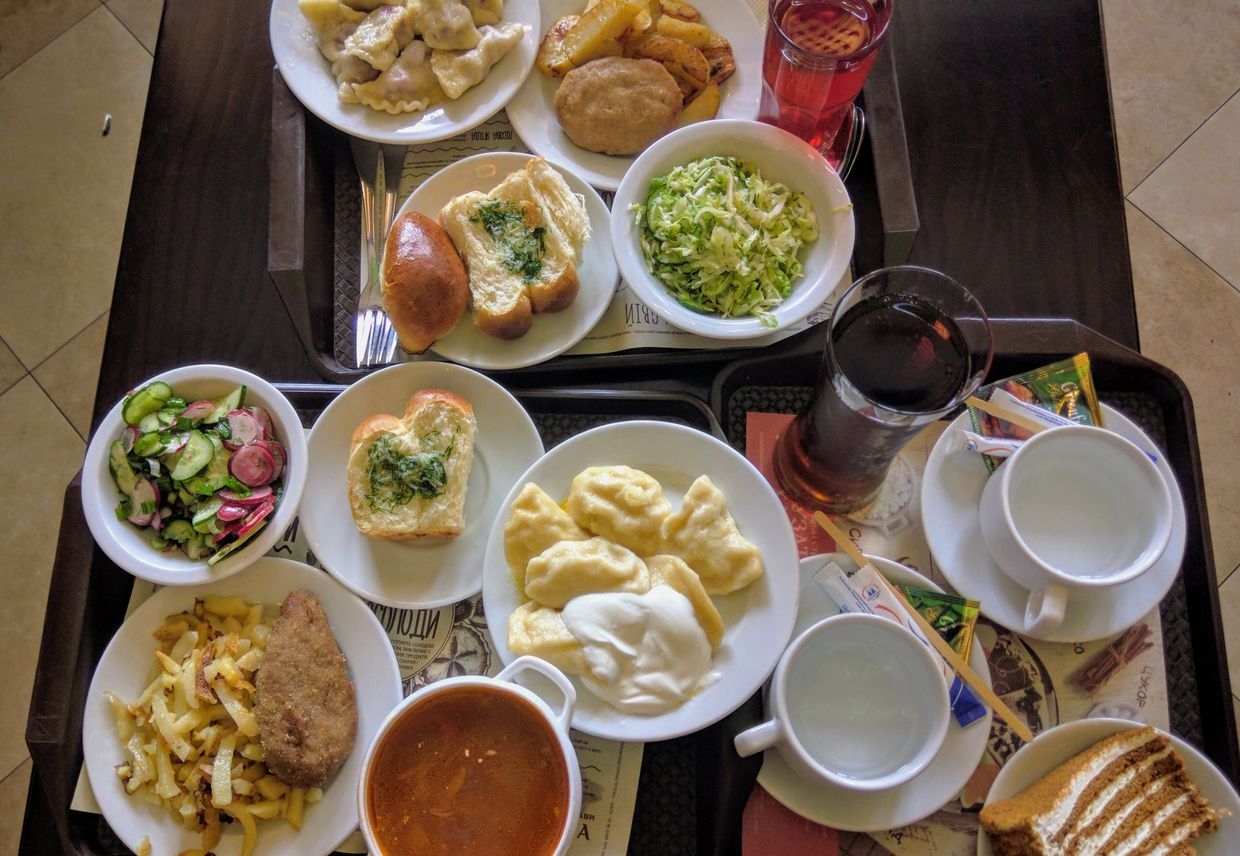Puzata Khata is a popular Ukrainian fast-food chain, founded in 2003, known for its buffet-style service of quick, affordable, and traditional homemade dishes. (The Kyiv Independent)
If there is one institution in Ukraine impervious to the sweeping decommunization efforts of the last decade, it’s the Soviet-era canteen, or stolovaya as it’s usually referred to in Russian.
An invention of the Soviet Union’s founding father Vladimir Lenin, the stolovaya (called yidalnia in Ukrainian) was meant to control scarce resources and “liberate” women from the kitchen by freeing them to pursue industrial occupations.
Stolovayas were ubiquitous in the USSR, where recipes were standardized and dispersed across the union making dining in a stolovaya a nearly identical experience from Kyiv to Tashkent to Vladivostok.
Ukraine’s buffet-style chain Puzata Khata (meaning “potbellied house” in Ukrainian) rose from the stolovaya’s enduring popularity throughout the Soviet Union, blending with it home-style Ukrainian dishes beloved among the local population.
The Kyiv-Donbas Development Group opened the first Puzata Khata restaurant on Oct. 16, 2003, in the historic Bessarabka area of central Kyiv, where it still is today.
The decor transported diners to an idealized, 19th-century Ukrainian village and served them affordable, traditional Ukrainian dishes in a buffet format.
Its style closely resembled popular upscale restaurants in Kyiv at the time, Ukrainian restaurant expert and co-founder of the National Restaurant Association of Ukraine, Olga Nasonova, told the Kyiv Independent.

During the first six years, the chain grew rapidly, opening 37 restaurants in 14 cities by 2009. It was on a comparable growth trajectory with McDonald’s Ukraine, one of the largest food chains in the country.
By tapping into a Soviet nostalgia common among older generations, and a general desire for quick and affordable food located conveniently close to work or home, as well as recognizable tastes, the brand has been able to maintain its widespread appeal.
“Puzata Khata will always be popular in Ukraine because the menu is based on deep national traditions of homemade food, the dishes are prepared from inexpensive, local ingredients and the benefits of good nutrition are ingrained in us (Ukrainians) from childhood,” Nasonova said.
The story of the chain’s beginning is also emblematic of doing business in Ukraine in the years following the collapse of the Soviet Union — its owners, two brothers, stumbled their way through organized crime in the 1990s between Kyiv, New York, and Israel before pivoting to becoming entrepreneurs that found themselves pulled into various political events of post-independent Ukraine.
“Doing business in Ukraine has always been difficult, which is why many owners of large businesses have colorful backgrounds,” according to Nasonova.
The storied brothers behind the buffet line
When Puzata Khata first opened, it was managed by the real estate conglomerate, Kyiv-Donbas Development Group. The group started in 1994 while Puzata Khata owners Vyacheslav Konstantinovsky and his twin brother Oleksandr were still living in Brighton Beach, New York City, working security for an organized crime boss.
Their initial partners were the influential Jewish-Odessan, Alexander Levin, and notorious banking magnate, Viktor Topolov — the same duo that would later be accused of siphoning public funds from the Ukrainian national budget.

The Konstantinovsky brothers returned to Ukraine in 1997. It was then that they started to combine several years of catering experience in Kyiv and Israel with nostalgia for the stolovaya and living in New York during the golden age of American fast food buffets. The recipe that would help Puzata Khata come to life.
In 2004, just as the chain was taking off, the Konstantinovsky brothers allegedly returned to their work as security guards. This time for Viktor Yushchenko, the pro-Western candidate of the Orange Revolution who would go on to become Ukraine’s third President.
According to their partner Viktor Topolov, the Konstantinovsky brothers started to take greater control of Puzata Khata’s management just after Odesan international crime boss Semyon Mogilevich orchestrated a murder attempt on their lives in 2006.
Then the global financial crisis hit. By 2010, the combined losses from the economic downturn and the swine flu epidemic had pushed the company into a very public, controversial bankruptcy proceeding. As a result, the Puzata Khata chain became entirely owned by the Konstantinovsky brothers.

Despite the need to refocus attention on the restaurants, when EuroMaidan started in late 2013, Vyacheslav Konstantinovsky was there. Early in 2014 he joined the Kyiv-1 volunteer battalion and spent two months in the ATO zone. By November, Konstantinovsky was sworn into the Ukrainian parliament representing the 220th district of Kyiv. Meanwhile, his brother Oleksandr remained focused on managing the Puzata Khata chain.
The line moves forward
Today, there is very little publicly available information about Puzata Khata. There are no “about us” or “our story” sections typical of successful consumer brands.
The most readily available information about career opportunities is on a Ukrainian employer review site, Vnutri, where dozens claim the company forces employees to take half of their payments in cash to avoid reporting tax liabilities.
The chain now employs more than 3,500 people across 36 locations in 6 cities. More than half are in Kyiv. The menu includes over 300 items which rotate monthly with a focus on home-style Ukrainian cuisine from across the country and the occasional international dish such as teriyaki noodles.
Nasonova notes that, “Many Ukrainians believe that a full meal is soup, salad, a hot dish and a drink and eating sandwiches is harmful. This is how food was structured in kindergartens, schools, and at home.”
Although Puzata Khata has retained some features of the Soviet stolovaya era, the business has made a conscious effort to avoid Soviet nostalgia.
This sits in stark contrast to similar restaurant concepts like Russia’s Stolovaya 57 or Varenichnaya No. 1 which enjoy widespread popularity in Moscow by featuring purposely stern waitstaff or Soviet propaganda posters.
Instead, Puzata Khata has leaned into its passionate fan base that goes there for the convenience of a quick and recognizably Ukrainian meal.
“This is a restaurant for food, not for relaxing or meeting friends,” points out Nasonova.





















